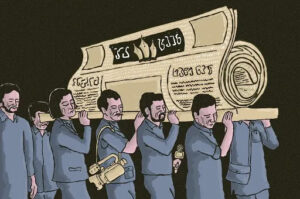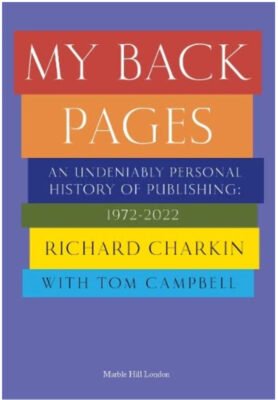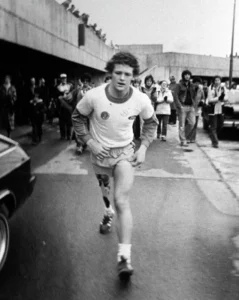
Disappearing media
This is the 199th edition of SHuSH, the official newsletter of the Sutherland House Inc.


This is the 193rd edition of SHuSH, the official newsletter of The Sutherland House Inc. If you’re new here, hit the button:
Fifty years ago, when Richard Charkin (above) began his career in the book trade, telephones were wired to desktops and editors (male) wrote their letters and memos in longhand, turning them over to women in the typing pool who knocked them out on carbon paper because the publishing world was slow to photocopiers.
Employees smoked at their desks and drank at lunch. Men wore suits and ties and hats; women long skirts. Living wages were paid and even mid-level jobs came with a car. It was not uncommon for people to spend their whole careers at a single company.
Charkin started at Pergamon Press, an Oxford-based scientific publisher. It held an annual Miss Pergamon contest, essentially a beauty pageant for female employees. The winner received a titled sash, cloak, crown, and the opportunity to greet VIP visitors at company events. Pergamon was considered a progressive company for its time. Needless to say, this was before the dawn of the HR department. Also before marketing and IT departments, but publishers did have guilds, members of which met to discuss business at the pub.
In the mid-1970s, Charkin moved from Pergamon to Oxford University Press, which had traditions of its own. For instance, fortnightly editorial conferences were held at 11 a.m. on Tuesdays (but not in summer when everyone was off on extended vacations). Editors attended in robes and sat around an enormous table. In front of them were inkwells filled with fresh ink.
Charkin worked out of OUP’s Ely House offices in Mayfair. Tea ladies pushed trolleys down the corridors once in the morning and again in the afternoon, dispensing drinks and biscuits. There were three dining rooms on the premises: “one in the basement for all staff, which provided hearty and generously subsidized fare, while on the second floor there was an officers’ dining room, reserved for editors and middle managers, where meals were prepared by a fine chef and the drinks were free. At the very top of the building was the publisher’s dining room, which was exclusively for the use of the head of the London office… and his guests. The food here was sourced from Jackson’s of Piccadilly and the wine list was excellent, with the cellar being overseen by a senior manager at OUP whose job involved spending at least a month in France every year researching and ordering directly from vignerons.”
Class distinctions were rigid enough that two sets of bike racks were required, one for editors, the other for printers. There were a lot of printers: OUP still manufactured its own books and made its own paper, that very thin but indestructible variety once common in Bibles.
You’ll be shocked to learn that Oxford University Press, in operation since 1478, was in deep financial trouble by the 1980s.
Charkin, whose memoir, My Back Pages, is now available, left OUP for senior roles at other outfits, including Macmillan and Bloomsbury. Most authors of publishing memoirs spend their careers on the editorial side of the business, commissioning or editing books. They write about their relations with authors and how books came together and what awards they won and how many copies they sold and who snubbed whom at so-and-so’s party. Charkin’s time was devoted to improving businesses, buying and selling them, and grappling with emerging technology and ever-changing business models. He has a broad and deep experience of the industry and an unsentimental perspective on how it actually works.

As you might guess from the paragraphs above, Charkin dwells on change. He is fascinated by the industry’s technological evolution from the strictly analog world of the 1970s through microfilm readers, CD ROM, dictaphones and telexes and fax machines right up to the age of digital commerce and the introduction of large language models. Also by those changing business models, from the decline of book clubs and mass market paperbacks to the advent of the chain bookstore and online retailing and the waves of consolidation that wiped out so many of the family-owned businesses he admired early in his career. That the offices once home to Miss Pergamon Pageants are now overwhelming staffed with and run by women to takes as a welcome surprise.
While obviously pleased by his own accomplishments and confident that the world (or some corner of it) wants to hear about them, he possesses a becoming humility born of hard experience. Echoing the screenwriter William Goldman’s comments about the film industry—“nobody knows anything”—he says that successful books are mostly luck: “from talking rabbits to schoolboy wizards, the greatest sellers of the last half-century have never been predictable.” Editors and publishers can take credit only for exploiting opportunities once they’re revealed as such.
Interestingly, Charkin identifies the same unpredictability on the business side of things. A lot of technologies that were supposed to change the publishing world, not least CD-ROM, flamed out while others such as the audiobook kicked around on the margins of the industry for many decades, only finding an important role when broadband gave us the ability to move and store large files.
In memoirs written from the editorial side, the author’s career will often turn on the discovery of an incredible talent or an important manuscript. Charkin’s turns on a business lesson learned in the 1980s: across all different types of publishing, “the most commercially successful were the ones with the shortest value chains.”
Publishers who sold reference works directly to librarians, or law books directly to lawyers, or scientific journals directly to scientists, made a lot more money than trade publishers who sold books indirectly to consumers through third-party retail outlets. The greater the distance between producer and consumer—the value chain—the more room for middlemen to extract value.
When Charkin started out, retailers kept 30 percent of the selling price of each book. By the time he’d retired from big-time publishing, the book chains and Amazon had enough clout to push retail discounts to 50 percent or more (while still reserving the right to return unsold product). As much as anything, he says, this development destroyed the prospects of contemporary trade publishing. On the purchase of a $30 book, retailers had helped themselves to another $6, which wiped out most of a publisher’s profitability.
Charkin was at Bloomsbury in the Aughts. It had just released the final volume in the schoolboy wizard series, Harry Potter and the Deathly Hallows, which sold 15 million hardcover copies in its first twenty-four hours. The company’s income doubled to £150 million pounds in 2007. Charkin got to spend a lot of that money, diversifying the company for its post-Harry future.
He cut Bloomsbury’s exposure to the consumer book market by buying academic publishers, military history specialists, the Wisden Cricketers’ Almanack (a subscription business), a fashion library, the Arden Shakespeare, a law and tax publisher, and so on. All these companies had in common were short value chains or well-developed niche markets in which they could command unusually high prices for their goods.
Charkin no longer has a big job but he is keeping his hand in the game. He’s launched a curious little operation called Mensch Publishing, which is as much a protest against the terms of trade in mainstream publishing as it is a business venture.

Because the big houses are preoccupied with blockbusters, Charkin targets mid-list authors.
Because it’s so hard to make money in a single market with retailers taking 50 percent, he demands world rights to every book he signs and sells those rights in other markets.
Because of the high risk that comes from publishers paying big advances for books that sell at low margins, he offers no advances and pays a 25 percent royalty instead of the usual 10 percent.
Because it’s devastating, financially and emotionally, to produce a big print run of a book and see pallets of it returned unsold from retailers for full refund, he relies on print-on-demand services and tries to sell directly to consumers (with a lot of online marketing).
I see no flaws in Charkin’s criticism of the mainstream publishing model. Mensch has only produced a handful of books, so it’s too early to call it a brilliant or quixotic endeavour, but I admire him for putting his convictions to the test at an age (seventy) when he could rest on his laurels.
I wondered as I read My Back Pages if Sutherland House should emulate some of what Charkin is doing. Probably we should, but we ordered editorial robes and a tea trolley instead.

This is the 199th edition of SHuSH, the official newsletter of the Sutherland House Inc.

There was an interesting piece in the New York Times a week or so ago about James Daunt (above), the incoming chief executive of Barnes & Noble, the most important bookstore chain in the English-speaking world. It didn’t quite get to the nub of the matter. Barnes & Noble has

The world of non-fiction from Sutherland House ( and Beyond )